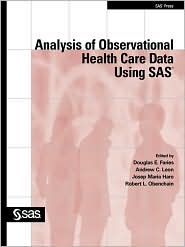Analysis of Observational Health Care Data Using SAS
Publisher: SAS Publishing (February 26, 2010)
Language: English
ISBN-10: 1607642271
ISBN-13: 978-1607642275
Product Dimensions: 10.9 x 8.3 x 1 inches
This book guides researchers in performing and presenting high-quality analyses of all kinds of non-randomized studies, including analyses of observational studies, claims database analyses, assessment of registry data, survey data, pharmaco-economic data, and many more applications. The text is sufficiently detailed to provide not only general guidance, but to help the researcher through all of the standard issues that arise in such analyses. Just enough theory is included to allow the reader to understand the pros and cons of alternative approaches and when to use each method. The numerous contributors to this book illustrate, via real-world numerical examples and SAS code, appropriate implementations of alternative methods. The end result is that researchers will learn how to present high-quality and transparent analyses that will lead to fair and objective decisions from observational data.
"This book, which is a collection of articles by experts, serves a vital need for a good general book on the subject of observational studies in medicine. The randomized control trial is not the only method of analysis, but observational studies have their special problems. This book concentrates on method such as propensity scoring and instrumental variables, pointing out the advantages and disadvantages of each. The technical level varies from chapter to chapter, but is generally fairly accessible. The chapters all have extensive references, and each has copious SAS code, with comments and output, to illustrate key ideas. If you analyze observational data in the medical field, you will want this book." --Peter Flom, Independent Statistical Consultant, Peter Flom Consulting, LLC
"Analysis of Observation Health Care Data Using SAS should be a required reference book available to health outcomes, economics, and epidemiology researchers at all levels, whether they are graduate students or experienced analysts. It contains much practical wisdom; describes the techniques, standards, and pitfalls of analyzing real world data; as well as provides actual computer code that should be immediately useful to analysts of 'real world' health care data. It even has references to publications that have applied such methods. This is a long awaited and much needed book, and I am hopeful that it will serve as a general guidance to improve the quality of research using observational data." --Howard G. Birnbaum, PhD, Principal, Analysis Group, Inc.


